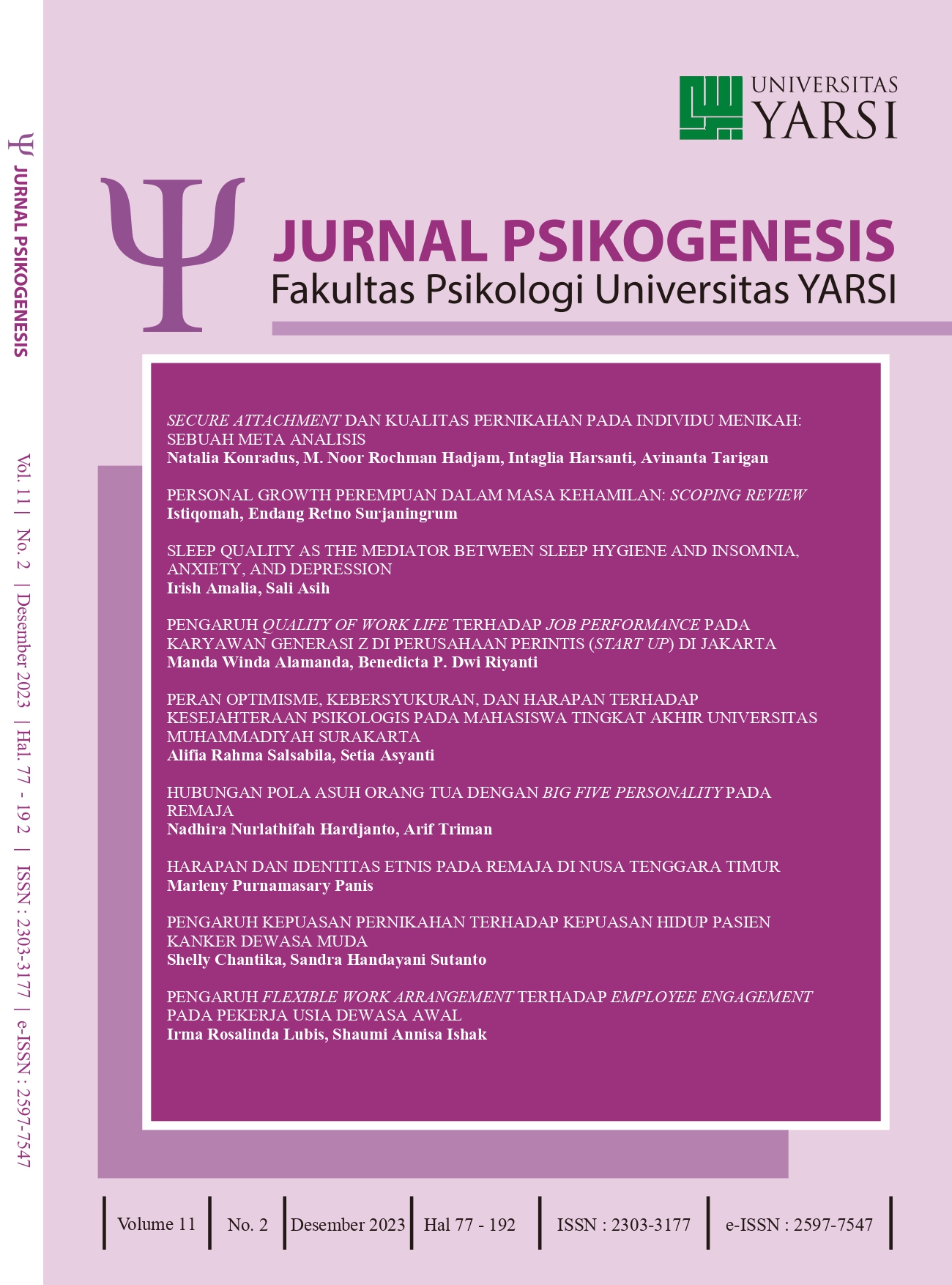Secure attachment Dan Kualitas Pernikahan Pada Individu Menikah: Sebuah Meta-Analisis
Kata Kunci:
Secure attachment, Kualitas Pernikahan, Meta-AnalisisAbstrak
Penelitian sebelumnya menunjukkan adanya hubungan antara secure attachment dan kualitas pernikahan pada individu menikah. Namun demikian korelasi antara secure attachment dan kualitas pernikahan menunjukkan hasil yang bervariasi. Meta-analisis ini bertujuan untuk mengevaluasi hubungan antara secure attachment dan kualitas pernikahan individu menikah dengan mengungkapkan seberapa besar true r dan effect size dari korelasi kedua variabel tersebut. Penelitian meta-analisis ini mengidentifikasi sebanyak 24 studi yang diaanggap memenuhi syarat dengan total sampel sebanyak 2.422. Hasil analisis mengonfirmasi adanya korelasi positif antara secure attachment dan kualitas pernikahan pada individu menikah pada level sedang dengan CI 95% (0,19; 0,43). Uji heterogenitas menunjukkan hasil yang baik dan tidak ada bias publikasi.Referensi
Ainsworth, M. D. S., Blehar, M. C, Waters, E., & Wall, S. (1978). Patterns of attachment: A psychological study of the strange situation. Hillsdale, NJ: Erlbaum.
Amani, R., & Khosroshahi, A. S. (2020). The structural model of marital quality based on secure attachment style through the mediating role of self-compassion, resilience, and perspective-taking. The American Journal of Family Therapy, 1-21. https://doi.org/10.1080/01926187.2020.1813653
Banerjee, S., & Basu, J. (2014). Personality factors, attachment styles and coping strategies in couples with good and poor marital quality. Psychol Stud, 1-9. https://doi.org/10.1007/s12646-013-0233-7
Bedair, K., Hamza, E., A., & Gladding, S., T. (2020). Attachment style, marital satisfaction, and mutual support attachment style in qatar. The Family Journal: Counseling and Therapy for Couples and Families, 28(3) 329-336. https://doi.org/10.1177/1066480720934377
Besharat, M. A., Naghshineh, N., Ganji, P., & Tavalaeyan, F. (2014). The moderating role of attachment styles on the relationship of alexithymia and fear of intimacy with marital satisfaction. International Journal of Psychological Studies, 6 (3), 106-117. https://doi.org/10.5539/ijps.v6n3p106
Bowlby, J. (1969). Attachment and loss: Vol. I. Attachment. New York: Basic Books.
Chellan, S. (2018). Effect of attachment styles on marital satisfaction. Shanlax International Journal of Arts, Science and Humanities, 5(4), 254-263.
Cohen, J. (1988). Statistical power analysis for the behavioral sciences (second edition). Hillsdale: Lawrence Erlbaum Associates, Publishers.
Collins, N. L. (1996). Working models of attachment: Implications for explanation, emotion, and behavior. Journal of Personality and Social Psychology, 71, 810-832. https://psycnet.apa.org/doi/10.1037/0022-3514.71.4.810
Diamond, R., M., Brimhall, A., S., & Elliott, M. (2017). Attachment and relationship satisfaction among first married, remarried, and post-divorce relationships Journal of Family Therapy, 1 – 17. https://doi.org/10.1111/1467-6427.12161
Feeney, J. A. (1994). Attachment style, communication patterns and satisfaction across the life cycle of marriage. Personal Relationships, 1, 333-348. https://doi.org/10.1111/j.1475-6811.1994.tb00069.x
Fincham, F. D., Bradbury, T. N. (1987). The assessment of marital quality: A reevaluation. Journal of Marriage and Family, 49(4), 797-809. https://doi.org/10.2307/351973
Fuller, T. L., & Fincham, F. D. (1995). Attachment style in married couples: Relation to current marital functioning, stability over time, and method of assessment. Personal Relationships, 2, 17-34. https://doi.org/10.1111/j.1475-6811.1995.tb00075.x
Gholizadeh, M., & Azizi, M. (2017, February 13–14). The Effectiveness of mindfulness on attachment styles in couples. [paper presentation]. First International Comprehensive Conference on Psychology. Educational Sciences and Social Sciences.
Hazan, C., & Shaver, P. (1987) Romantic love conceptualized as an attachment process. Journal of Personality and Social Psychology, 52, 511–524.
Hazan, C., & Shaver, P. R. (1994). Attachment as an organizational framework for research on close relationships. Psychological Inquiry, 5(1), 1–22. https://doi.org/10.1207/s15327965pli0501_1
Hoseinabad, S., F., H., Banab, B., G., Mashayekh, M., Sodagar, S., Farrokhi, N. (2018). An investigation of predictive marital adjustment base of attachment styles in iranian married women. Journal of Community Health Research, 7(3), 147-154.
Kamey, B. R., & Bradbury, T. N. (1995). The longitudinal course of marital quality and stability: A review of theory, method, and research. Psychological Bulletin, 118, 3-34 https://psycnet.apa.org/doi/10.1037/0033-2909.118.1.3
Mardani, M., Marashi, S. A., & Abbaspour, Z. (2021). On the causal relationship between attachment styles and marital satisfaction: mediating role of Gottman’s marital communication model. Psychiatry Behaviour Science, 15(2), 1-8. https://doi.org/10.5812/ijpbs.108339
Mohammadi, K., Samavi, A., & Ghazavi, Z. (2016). The relationship between attachment styles and lifestyle with marital satisfaction. Iran Red Crescent Medical Journal, 18(4), 1-6. https://doi.org/10.5812%2Fircmj.23839
Nadiri, M., & Khalatbari, J. (2018). Study of marital satisfaction in students based on psychological components of attachment style, perfectionism and conflict resolution. Broad Research in Artificial Intelligence and Neuroscience, 9 (3), 120 – 127.
Page, M. J., McKenzie, J. E., Bossuyt, P. M., Boutron, I., Hoffmann, T. C., Mulrow, C. D, dkk. (2021). The PRISMA 2020 statement: An updated guideline for reporting systematic reviews. BMJ, 10 (1), 89. https://doi.org/10.1371/journal.pmed.1003583
Robles, T. F., Slatcher, R. B., Trombello, J. M., & McGinn, M. M. (2014). Marital quality and health: A meta-analytic review. Psychological Bulletin, 140(1), 140–187. https://psycnet.apa.org/doi/10.1037/a0031859
Senchak, M., & Leonard, K. E . (1992). Attachment styles and marital adjustment among newlywed couples. Journal of Social & Personal Relationships, 9, 51-64. https://doi.org/10.1177/0265407592091003
Spanier, G. B., & Lewis, R. A. (1980). Marital quality: A review of the seventies. Journal of Marriage and the Family, 42(4), 825–839. https://psycnet.apa.org/doi/10.2307/351827
Tucker, J. S., & Anders, S. L. (1999). Attachment style, interpersonal perception accuracy, and relationship satisfaction in dating couples. Personality & Social Psychology Bulletin, 25, 403-412. https://psycnet.apa.org/doi/10.1177/0146167299025004001
Umberson, D., Williams, K., Powers, D.A., Liu, H., Needham, B. (2006). You make me sick: Marital quality and health over the life course. Journal of Health and Social Behavior 47, 1–16. https://doi.org/10.1177/002214650604700101
Wickrama, K.A.S., Lorenz, F.O., Conger, R.D., Elder, G.H. (1997). Marital quality and physical illness: a latent growth curve analysis. Journal of Marriage and the Family 59, 143–155. https://doi.org/10.2307/353668
Williams, K. (2003). Has the future of marriage arrived? A contemporary examination of gender, marriage, and psychological well-being. Journal of Health and Social Behavior 44, 470–487. https://doi.org/10.2307/1519794
Yuspendi, Lie., F., F., & Maria, C. (2015). Adult attachment and personality traits and the quality of marriage of husband and wife couples. Anima, Indonesian Psychological Journal, 30 (3), 127-138. https://doi.org/10.24123/aipj.v30i3.542
Unduhan
Diterbitkan
Cara Mengutip
Terbitan
Bagian
Lisensi
Hak Cipta (c) 2024 Natalia Konradus

Artikel ini berlisensiCreative Commons Attribution-NonCommercial-ShareAlike 4.0 International License.
Authors who publish with this journal agree to the following terms:- Authors retain copyright and grant the journal right of first publication with the work simultaneously licensed under a Creative Commons Attribution License that allows others to share the work with an acknowledgement of the work's authorship and initial publication in this journal.
- Authors are able to enter into separate, additional contractual arrangements for the non-exclusive distribution of the journal's published version of the work (e.g., post it to an institutional repository or publish it in a book), with an acknowledgement of its initial publication in this journal.
- Authors are permitted and encouraged to post their work online (e.g., in institutional repositories or on their website) prior to and during the submission process, as it can lead to productive exchanges, as well as earlier and greater citation of published work (See The Effect of Open Access).

 Natalia Konradus
Natalia Konradus
 Universitas Gunadarma
Universitas Gunadarma










